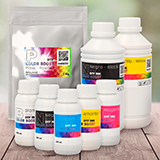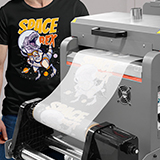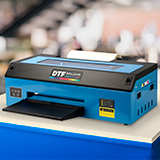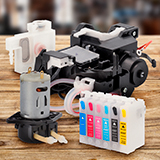How to make DTF transfers
DTF or "Direct To Film" is the most innovative digital printing technique with which you can personalise textiles of almost any composition or colour as well as hard substrates.
Find the answers to your questions here:
- What is DTF printing?
- What do you need to make DTF transfers?
- How does DTF printing work?
- Want to know more?
What is DTF printing?
It is a digital printing technique that consists of printing a design on a film and then transferring it with a heat press to a fabric or hard substrate. It is a relatively new technology that has quickly gained popularity as you can print high-quality designs on fabrics of any colour made of cotton, polyester, blends and more.
Top ↑
What do you need to make DTF transfers?
- DTF printer: this is a digital printer loaded with special DTF inks to print onto PET film.
- DTF ink: this is a special type of ink designed to work with DTF printers and films. It is generally made from water-based pigment ink that has a high viscosity, which makes it easy to adhere to both the film and the final fabric or substrate. Also designed to dry quickly and resist fading, cracking and peeling, even after several washes. Those who already have a DTG system will be pleased to know that they can also use their digital prints with this DTF system.
- DTF film: special film for DTF printing that serves as a support for the ink in the intermediate step before it is transferred with the heat press to the final fabric or substrate. It is usually a polyester film coated with a special adhesive layer that allows the ink to adhere to the film.
- Hot-melt adhesive powder or DTF powder: it has to be sprinkled on top of the freshly printed print when it has not yet fully dried and can adhere to it. When it is then heat pressed, it melts creating a strong bond that resists washing and other wear conditions.
- Heat press machine: used to transfer the design to a fabric or substrate by applying heat and pressure. Available in many different models, depending on the surface and other features expected of them.
- RIP software: specialised software that helps to process and prepare the design file for colour optimisation in printing.
Top ↑
How does DTF printing work?
- Design creation: the designs can be created with any commercially available graphic design software.
- RIP processing: regardless of the source of the design, it has to be processed with RIP software for colour optimisation.
- Printing the design: the processed design must be printed in mirror image on the DTF film.
- Applying the DTF powder: after printing, you should apply a layer of hot-melt adhesive powder to the design using a shaker or electrostatic powder coating equipment.
- Curing of the DTF powder: after applying the DTF powder, it must be cured with heat so it bonds.
- DTF transfer: once the powder is cured, the DTF film is ready to be heat pressed on the fabric (or hard substrate).
- Removing the transfer film: all that is left to do is removing the film to reveal your printed design.
DTF printing creates vibrant, durable, high-quality prints with excellent washing and abrasion resistance, making it a very popular choice.
As well as being simple, it is also cost-effective.
Top ↑
Want to know more?
These are some of the posts you should read:
- DTF Printing: A Game-Changing Technique For Your T-Shirt Business
- DTF Printing: Problems And Solutions
Don’t forget to check out these videos too:
- What is DTF printing? Is it worth it? Everything you need to know
- The best DTF software
- DTF Printing: maintenance, problems and solutions
Top ↑




